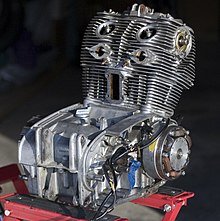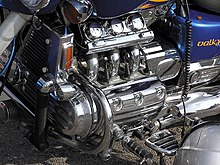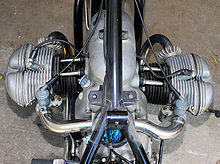The first motorcycles were powered by steam engines. The earliest example is the French Michaux-PerreauxRoper steam velocipede of 1869, and a number of other steam powered two and three wheelers, manufactured and sold to the public on through the early 20th century.[2] steam bicycle of 1868. This was followed by the American
Using frames based both on the earlier boneshaker and the later — and in many ways completely modern — safety bicycle design, these early steam motorcycles experimented with a variety of engine placement strategies, as well as transmission and options. While today nearly every motorcycle has its engine in the center of the frame, this became standard only around 1900-1910[verification needed] after nearly every possible engine location was tried. The modern scooter engine arrangement was arrived at in the 1940s[verification needed] and remains the same today.[2]
Almost all commercially available motorcycles are driven by conventional gasoline internal combustion engines, increasingly four-strokes in all size ranges. Some are still air-cooled (forced with a fan in some cases) but water-cooling is more common. The mid-range and large two-strokes seen in the 1970s and 1980s have almost disappeared, particularly as emission laws were introduced. There are a few small scooter-type models using batteries and an electric motor. Van Veen, Hercules, Norton, and Suzuki produced quite small numbers of motorcycles propelled by Wankel rotary engines. The 2009 TT races included a new category 'TTX' for electric bikes using either fuel-cells or batteries
Most motorcycle engines have the primary working member or crankshaft across the frame (transverse mounting). Others are arranged to turn a shaft-drive to the rear wheel and the crankshaft is longitudinal, along the frame.
A sub-type of motorcycle, the scooter, has the engine as part of the rear suspension, so it is not fixed to the main frame. Such engines pivot to follow the road surface and are partly "unsprung weight". The final drive of scooters is much shorter than that of regular motorcycles and is contained within the engine casings in an oil-bath, a design that is only suitable for machines with small wheels[verification needed], or is fully automatic using belts and expanding/contracting pulleys, ala DAF variomatic cars. The engines of the motorcycles known as underbones or "step-throughs" may be of either kind.
Cylinders
Small motorcycles normally have a single cylinder, many smaller and mid-range motorcycles have twin cylinders and most medium to large motorcycles have four cylinders. However, no generalizations can be made, as there are a few large singles and twins. Three cylinders have been widely used and there have been some six-cylinder machines. Many different layouts have been used with vertical cylinders the most popular. There are some horizontally opposed and V layouts.
Single

1960 BSA Gold Star
Main article: Single cylinder engine
Single cylinder engines (known as "singles" or occasionally "thumpers") may have the cylinder vertical or horizontal, the latter particularly common in step-through or underbone motorcycles. Single cylinder engines require a larger flywheel, hindering ultimate performance but are a lot easier to maintain in almost every respect. In road motorcycles, single-cylinders tend to be associated with cheaper, utility motorcycles for daily transport. These motorcycle engines are tuned to give more power at lower engine revolutions, improving control, safety and engine longevity.The need for the flywheel effect is less pronounced in all forms of competition motorcycles since they spend almost no time at tick-over speeds, all through the 1950s many of the fastest road racing motorcycles such as the Manx Norton were single-cylindered. The reduced weight and narrow width of single-cylinder motorcycles continue to make the layout well suited for the great majority of off road motorcycles, including those in top competition.
Split Single (a radical form of two-stroke) were used very successfully by DKW and Puch between and after the wars, losing out only to the loop-scavenging Japanese twin and triple machines of the 1970s.
Twin
Parallel-twin

1962 Honda CB77 Superhawk 305 cc (18.6 cu in) twin engine.
Main article: Straight-two engine
Two-cylinder engines are known as twins. The parallel twin as in most common British and many Japanese motorcycles. Engines of this design typically have the cylinders side by side vertically above the crankcase, maximizing airflow cooling. Longitudinal twins include the 500 cc Sunbeam S7 and S8.The parallel-twin engine configuration was made famous by Edward Turner's Triumph Speed Twin design as used on the Bonneville.
[edit] V-twin

Harley-Davidson Sportster V-twin
Main article: V-twin
The V-twin where the cylinders form a "V" around the crankshaft, which is oriented longitudinally on models such as on the Honda CX500 and most Moto Guzzi motorcycles, or transversly.[8] V-twins can also be separated into two types, one having a shared crankpin (a normal con-rod is inserted between a forked con-rod thus sharing the single crankpin and keeping the cylinders in line, which gives the distinctive Harley-Davidson sound; and the other with two crankpins, with the cylinders staggered, which nearly every one else uses.The angle in the V-twins varies from around 45 degrees to 90 degrees. Typical of the former are the Harley-Davidson and Vincent engines which because of their firing order tend to vibrate more. Ducati and Moto Guzzi make V-twins with cylinders arranged at a 90 degree angle to quell primary vibrations. Moto Guzzi motorcycles since the 1960s have V-twins with the crankshaft oriented longitudinally and the cylinders pointing upwards, left and right.
Flat twin
Main article: Flat twin
The opposed twin in which the cylinders protrude sideways into the cooling air stream.In the flat-twin (boxer) engine, which is used by BMW Motorrad, Ural and historically by Douglas, the cylinders are horizontally opposed, protruding from either side of the frame. The boxer is the only twin-cylinder arrangement that has inherent primary balance without a rocking couple, producing very low vibration levels without the use of counterbalance shafts.
Tandem twin
Main article: U engine
The Tandem Twin where the cylinders are longitudinal, and have two cranks geared together such as Kawasaki's KR250 road bike and KR250 and KR350 GP Bikes.Triple
Main article: Inline-3
Three-cylinder designs are referred to as "triples" and are normally inline triples in layout. The British Hinckley-built Triumph, mostly transverse but also the 2,300 cc longitudinal Rocket III, Italian Benelli and Japanese Yamaha XS750 are three motorcycle manufacturers who have used triples in their large displacement motorcycles. The Italian firm Laverda made a few 1,000 cc and 1,200 cc triples. BMW made the K75 longitudinal 750 cc triple with the cylinders parallel to the ground. BSA made the Rocket-3 transverse 750 cc and old Triumph the 750 cc TridentTwo-stroke triples were somewhat more common historically. Kawasaki produced 250, 350, 400, 500, and 750 triples, which were known[by whom?] for their power (but maybe not rideability) in the 1970s while Suzuki produced 380, 550, and 750 triples (the last being water cooled). Motobecane made 350 cc and fuel injected 500 cc triples with 3 into 4 pipes in the early seventies. Honda produced the water cooled V-3 two-strokes MVX250 and NS400. There have been various race bike triples such as Kawasaki KR750, Suzuki TR750 transverse 3's, and Proton/Modenas KR3, Honda NS500 V-3s.
Four
Four-cylinder engines are most commonly found in a transverse-mounted inline four layout, although some are longitudinal (as in the earlier BMW K100). V-4 and boxer designs (as in the earlier Honda Gold Wing) have been produced. One of the more unusual designs was the Ariel Square Four, effectively two parallel-twin engines one in front of the other in a common crankcase – it had remarkably little vibration due to the contra-rotating crankshafts. Since the advent of Honda's CB750 straight-four engine, straight-fours have dominated the non-cruiser street motorcycle segments. The German manufacturer Münch based their motorcycles on four cylinder car engines (e.g. Mammut 2000 has a 2.0l with a turbo and cylinder heads by Cosworth).Inline four

Honda CB750 transverse inline-4
Main article: Inline-4
| This section requires expansion. |
Flat four
Main article: Flat-4
| This section requires expansion. |
V-four

Honda VFR1200F engine with dual clutch transmission.
Main article: V4 engine
Honda uses V4 engines in the ST series and VFR series. As for two-strokes, there were four cylinders in the smaller classes such as Kawasaki's 125 cc KR3 square 4 and Yamaha's 250 cc RD500 V4 (RZ 500 in the US). Yamaha later raced transverse four TZ500/700/750's and virtually all the bikes in the last decade of the two-stroke GP500 era were fours (first squares then Vees) i.e. Honda, Kawasaki, Cagiva, Suzuki, Yamaha - Kawasaki also experimented with a trapezoidal four the 602S. Yamaha made the V4 RD500LC, and Suzuki the RG400 and RG500 square four road bikes.Square four
Main article: U engine#Square four engine
A square four is a U engine with two cylinders on each side. This configuration was used on the Ariel Square Four motorcycle from 1931 to 1959. This design was revived as a two-stroke version on some racing SuzukiRG500. Although some racing success was achieved, the road bikes didn't sell in great numbers, and the design was phased out in favour of in-line, four-stroke designs, as at the time two stroke engines were quickly being superseded by more economical, reliable, and emissions-friendly four-strokes. models, and their subsequent road-going version the V-five
Main article: V-5 engine
Honda has produced five-cylinder engines for racing, the RC211V 990 cc V-five and the RC148 and RC149 125 cc straight fives, and Verdal made a radial Five 750 racer in 1912. There have also been five-cylinder rotaries that are installed in the front or back wheel, but no five-cylinders are currently available for commercial production motorcycles.Six
Inline six

Benelli Sei inline-6
Main article: Inline-6
Six-cylinder engines are rare and found only on the biggest motorcycles. Two easily recognizable examples in recent times have been the Honda CBX and the Kawasaki KZ1300 and also Kawasakis Voyager XIII, Bennelli also made 750 cc and 900 cc Straight sixes known as the Sei. Laverda fielded a transverse 1000cc V-Six in endurance racing, and Honda made a 250 cc straight Six GP Bike.Flat six

Honda Valkyrie flat-6
Main article: Flat-6
The six-cylinder engine is currently used by Honda in the boxer engine of the Rune, Valkyrie and Gold Wing.V-8
Main article: V-8 engine
Galbusera built a V8 in 1938, and Moto Guzzi experimented over a period of two years with its dual overhead cam 500 cc V8 (the Otto Cylindri) in the 1950s. Some custom and one-off motorcycles use more than six cylinders. For example, the Boss Hoss motorcycle uses a Chevy V-8 motor (5,700 cc and 6,000 cc). In the 1990s Daimler-Chrysler manufactured a limited number of Tomahawk concept bikes featuring a Dodge Viper's V-10 engine. Australian company Drysdale have built short runs of 750 cc V8 superbikes and 1L V8 roadgoing motorcycles, both with engines specifically developed for the purpose. No major motorcycle manufacturer has used eight or more cylinders although Honda made the 'almost' V8 oval piston NR750 road bike and NR500 GP bike (having eight connecting rods, for example) and Morbidelli has shown two V8 prototype road bikes, but has yet to get off the ground










0 Pendapat hati:
Post a Comment